For a genre so in love with caves, dungeon crawls sure spend a lot of time in some awfully barren caverns, geologically speaking. To help make your underground adventures awesome, let’s talk about cave formations, more properly called ‘speleothems’. We’ll focus on examples that are easy to describe (so they don’t slow down play), good combat terrain, evocative of something cool, or otherwise immediately gameable!
This post is brought to you by beloved Patreon backer Justin Moor. Thanks for helping keep the lights on! If you want to help keep this blog going alongside Justin, head over to the Patreon page – and thank you!
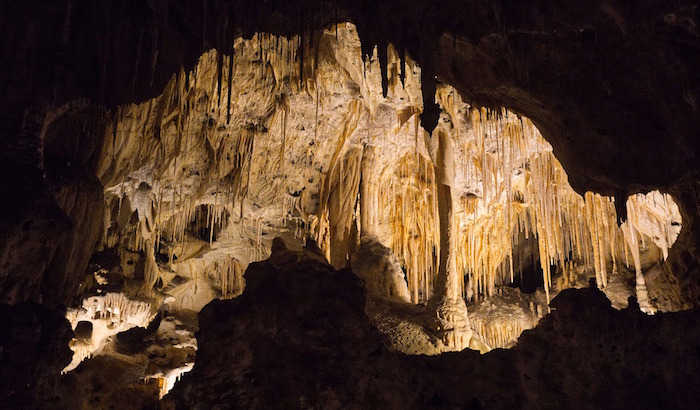
First, a quick detour to explain how speleothems form. Soil gas (the air found in the dirt between the grains and bits that make it up) has up to ten times as much carbon dioxide as atmospheric air. Rainwater trickling through the soil picks up that carbon dioxide. When the gas dissolves in the water, small amounts disassociate and form carbonic acid. That acid dissolves the highly-soluble calcium carbonate found in many soils and rocks. The deeper the water seeps into the soil, the more carbon dioxide and calcium carbonate it picks up.
Then the water enters a cave. Caves that have an opening somewhere (even a small one!) exchange air with the atmosphere, so have less carbon dioxide than the soil gas does. Carbon dioxide diffuses out of the water into the air. Without the carbon dioxide, the water is far less acidic, so all that calcium carbonate dissolved by the acid also has to come out of solution. Thus, as a drop of water rolls down the wall of a cave, it leaves behind an imperceptible trail of calcium carbonate, crystallizing usually as one of two white minerals: calcite or aragonite. Impurities in the mineral can make it brown, cream, yellow, orange, red, blue, or green. Given enough time, this process forms speleothems!
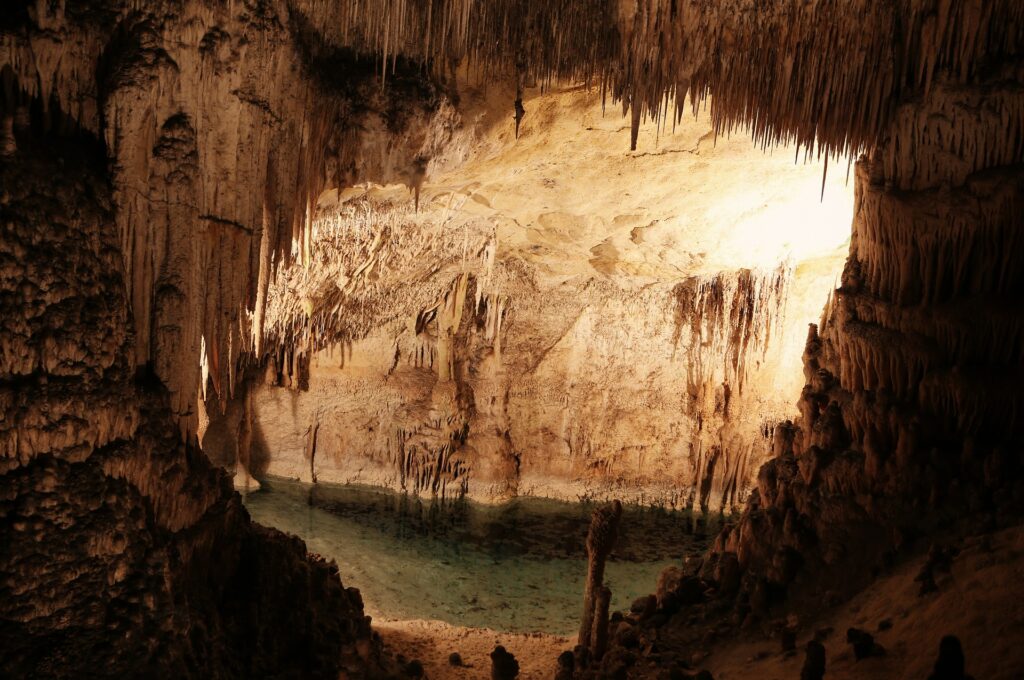
Your best-known speleothems are stalactites and stalagmites (collectively, ‘dripstone’). Water dripping from the ceiling deposits minerals where the droplet clings before it falls. Over time, the deposits build up, forming a downward-pointing stalactite. Stalactites are usually slender and delicate, like icicles. Stalactites made of epsomite can be clear as glass. Imagine the light show made by torches in a chamber decorated by a forest of epsomite stalactites!
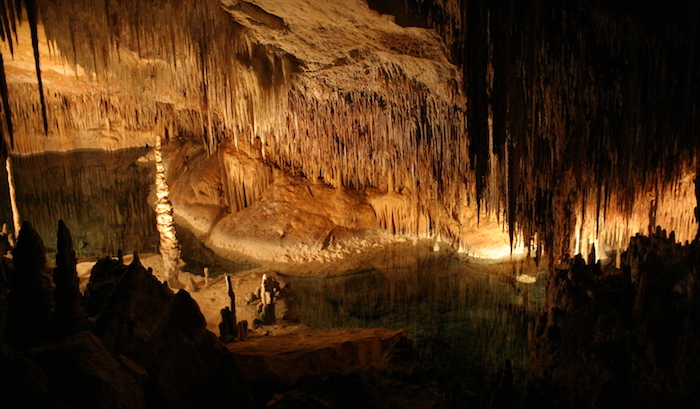
Image credit: Cuevas del Drach. Released under a CC BY 2.0 license.
‘Soda straws’ are remarkable and aptly-named stalactites. They are slender, no wider than a single drop of water, and perfectly hollow. Water slowly runs down the center of a soda straw. Each droplet deposits more minerals at the tip, lengthening the straw without widening it or filling in the center. The walls are not even half a millimeter thick. Most soda straws are less than fifty centimeters long, but some clock in at nearly ten meters. They are very fragile. One can easily imagine them serving as reagents or spell components. A liquid poured or sucked through a soda straw might gain some sort of power. Or cavern-dwellers might jealously guard these fragile wonders.

Image credit: SebiPB. Released under a CC BY-SA 4.0 license.
The droplet also deposits minerals where it lands, forming an upward-pointing stalagmite. If the ceiling is high enough that the droplets really splatter, the stalagmite may be covered in stony blades, fingers, and leafs. Stalagmites are typically shorter, stouter, and consequently stronger than stalactites. They’re still more fragile than you might expect, given that they are, after all, rocks.
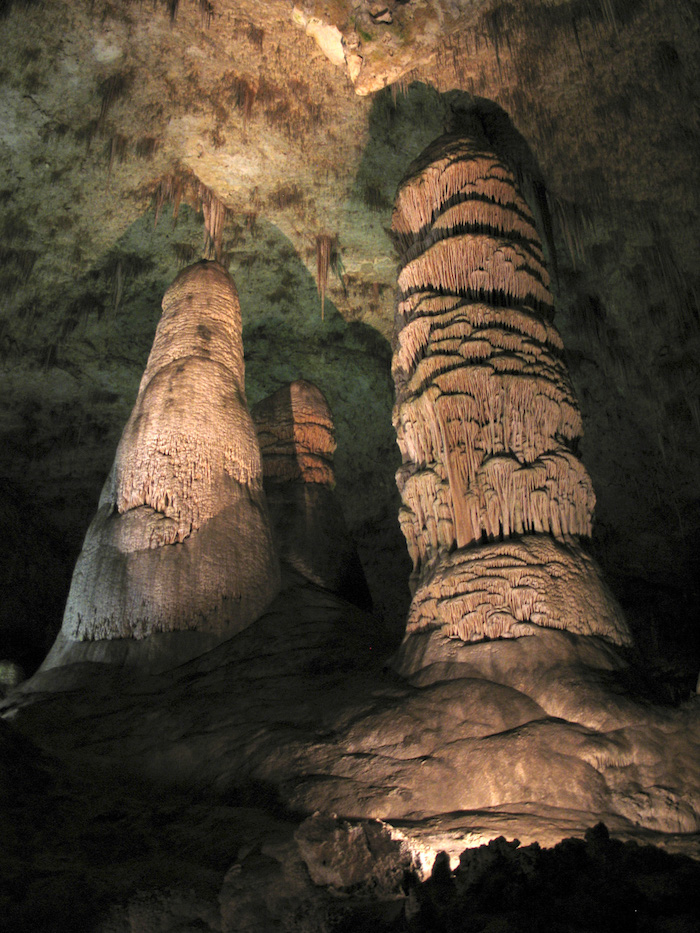
If cave conditions continue uninterrupted long enough, a stalactite and stalagmite will touch and fuse, creating a column. Younger columns are shaped not unlike hourglasses. Lines of columns (typically following a thin fissure in the rock overhead) may eventually themselves fuse, forming an ornate wall of dripstone.
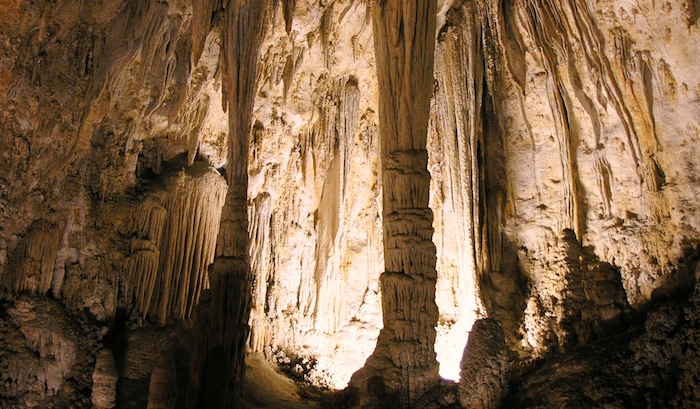
Image credit: Daniel Mayer. Released under a CC BY-SA 3.0 license
Closely related to dripstone, flowstone is named because it looks like flowing water frozen mid-motion. Many cavern walls are coated in flowstone left behind by the water that flows (or once flowed) down them. In large chambers, these formations may resemble mighty waterfalls! If the substrate a flowstone forms on – like a boulder or cave wall – later erodes away, it will leave behind a thin curtain of flowstone that subdivides the room.
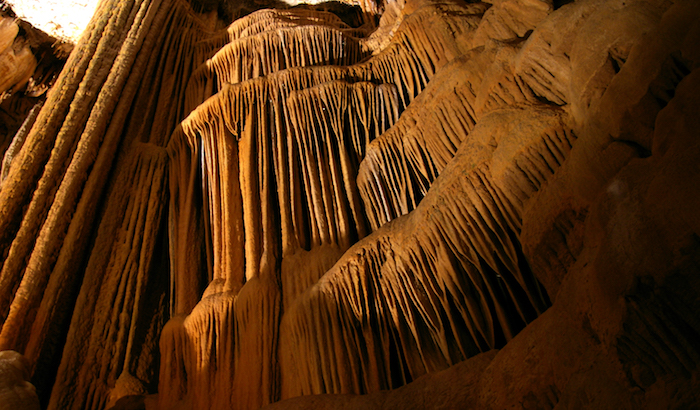
Image credit: Martin Souchay. Released under a CC BY SA-3.0 license.
One particularly dramatic example of flowstone is the ‘bell hood’ that can form atop an older feature, resembling little more than a creepy cowl. Stalagmites with bell hoods already resemble cowled figures; if your PCs discover an actual statue in a cave with a natural-seeming bell hood upon it, they won’t soon forget it! It’s a great way to flag a statue as important.
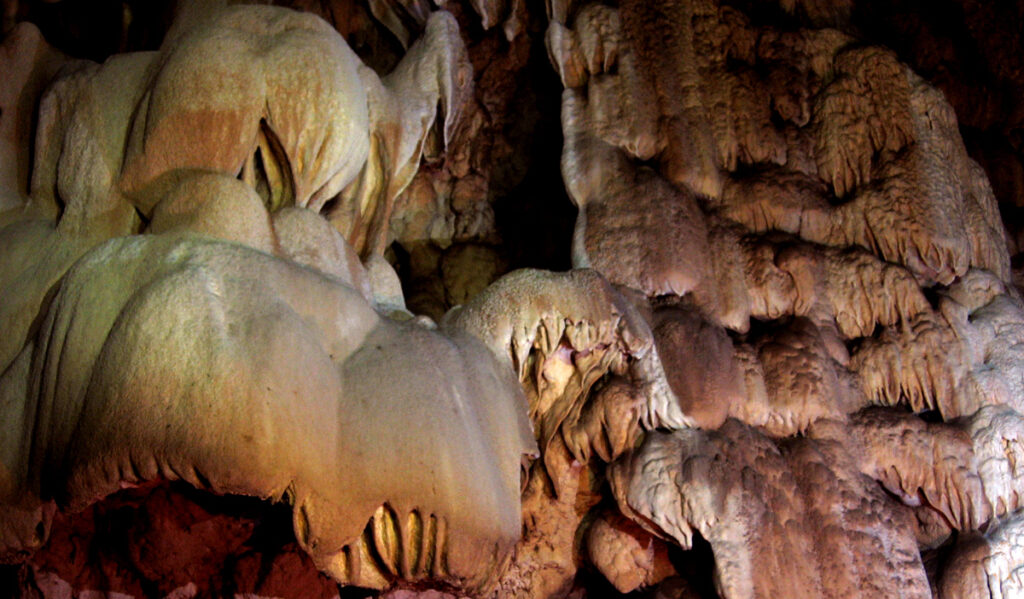
Image credit: Tommy from Arad. Released under a CC BY-2.0 license.
Flowstone combines well with columns to create destructible terrain. Imagine a curtain of columns, stalactites, stalagmites, and flowstone. Its irregular composition means it has natural doorways and windows in it. Such a curtain wall is likeliest to be found running the length of a long, narrow chamber with the tunnel continuing out either end. Dividing the room this way creates an interesting combat situation. You’ve essentially created two long, parallel hallways separated by a porous barrier through which a few small combatants can slip every round. Anyone wanting to open one of these holes wider can certainly do so; all this stone is brittle and wreckable.
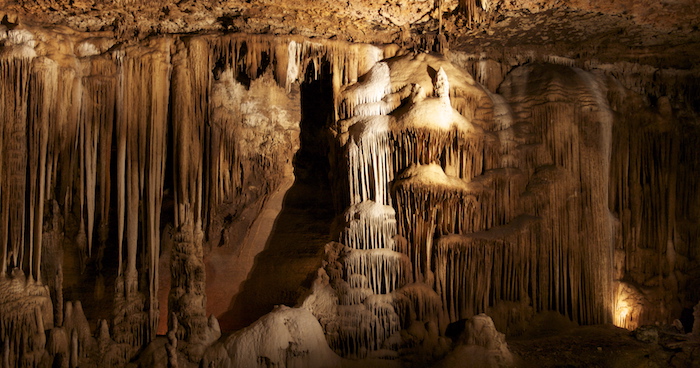
There’s lots more cool stuff to cover a cavern wall with than flowstone, though! Scintillites are formations of quartz found in caves. Unlike the opaque off-white of most flowstone, scintillites are clear and brilliantly reflective. They’re usually only found in caverns that were once full of water, especially hot water, where they slowly crystallized out like a kid’s rock candy experiment. Scintillites often take the form of short dangling sticks covered in small crystals. Because of their rarity, you might use scintillites as a valuable treasure or to signal the presence of magic.
In water-filled chambers, calcite can also coat the walls with crystals. This coating of ‘dogtooth spar’ is so named because the crystals are short, hard, and sharp. A wall covered in dogtooth spar is beautiful and memorable, but it’s one heck of a thing to be slammed into during combat by a bullrushing adversary.
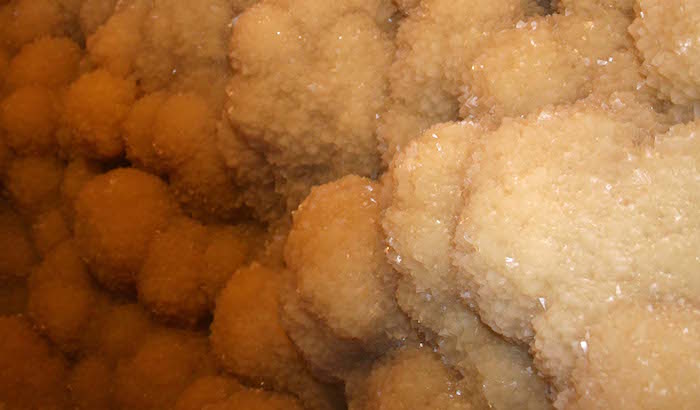
Image credit: DanielCD. Released under a CC BY-SA 3.0 license.
‘Folia’ are a kind of speleothem that look almost exactly like bracket fungi, those flat mushrooms that grow out of the sides of trees. Folia form in a manner analogous to shelfstone (below). They don’t have much immediate use, but their presence is a good way to distinguish a chamber as being different. (“Did we talk that myconid in the room with the flowstone waterfall or the stone fungus wall?”)
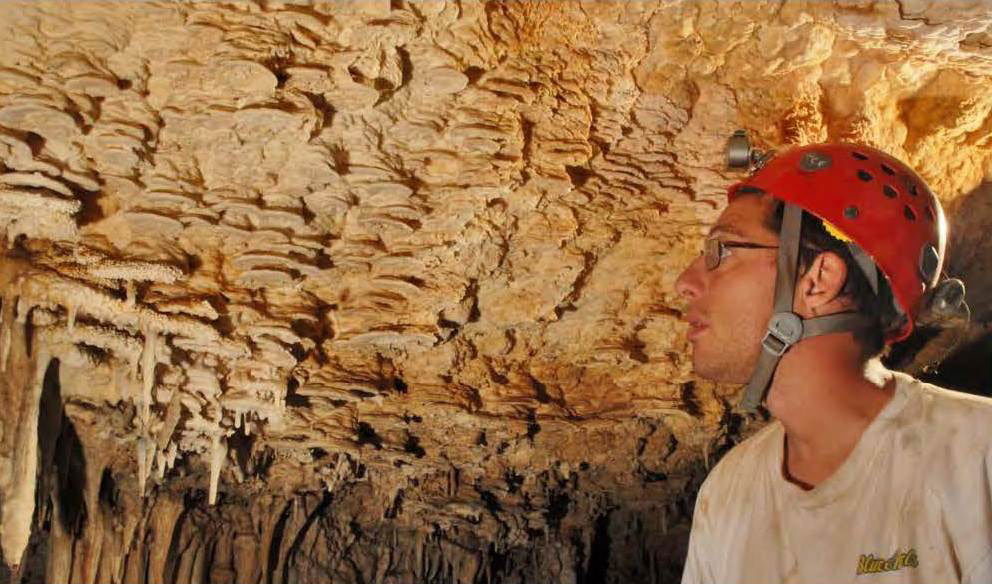
Finally for wild things to find on walls, we have moonmilk. It’s made of densely-packed microscopic crystals that hold moisture like a sponge. It has a visually rubbery texture. To the touch, it is soft and pliant as cheese. It’s shaped like ordinary flowstone, but it is super clearly not. Moonmilk might be sacred to a deity, have magical powers, or be a sign there’s an extraterrene rift nearby.
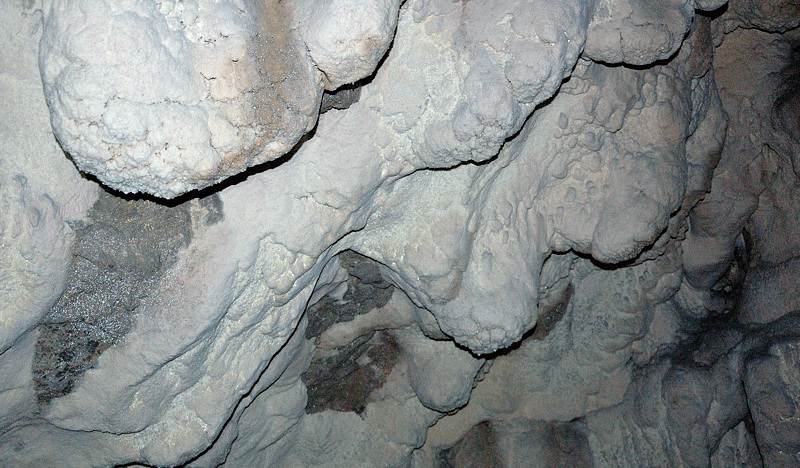
Image credit: Doronenko. Released under a CC BY-SA 3.0 license.
All that’s great for covering the walls, but what about stuff to put on the floor? First, let’s talk about cave pearls! These are spheres of calcite or aragonite ranging in size from a few millimeters to five centimeters in diameter! They’re made of layers of mineral around a grain of sand, not unlike regular pearls. It’s not entirely clear how they form, especially given that they’re not attached to the cave floor. They can be found in shallow pools or depressions. Cave pearls could be a neat quest object; they might be needed for a ritually significant necklace.
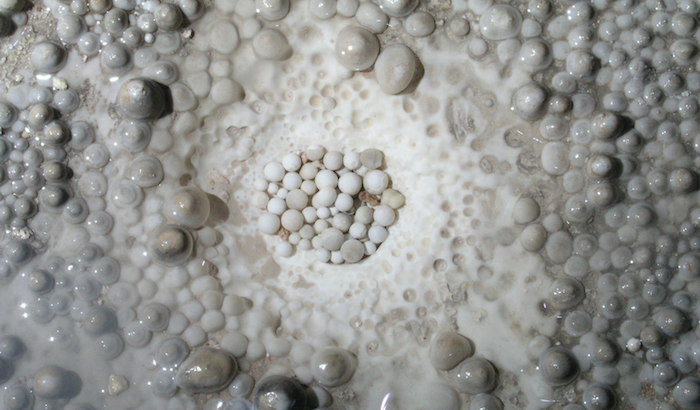
Image credit: WTucker. Released under a CC BY-SA 3.0 license.
Frostwork is made of tiny, delicate needles of white aragonite. It bears a striking resemblance to the hoarfrost that sometimes forms on chilly, still mornings. It can cover floors, walls, and ceilings, and is especially dramatic when it forms under a drip point. There, it creates a structure that resembles a fir tree a few centimeters tall, but hollow in the middle where the falling droplets pass through.
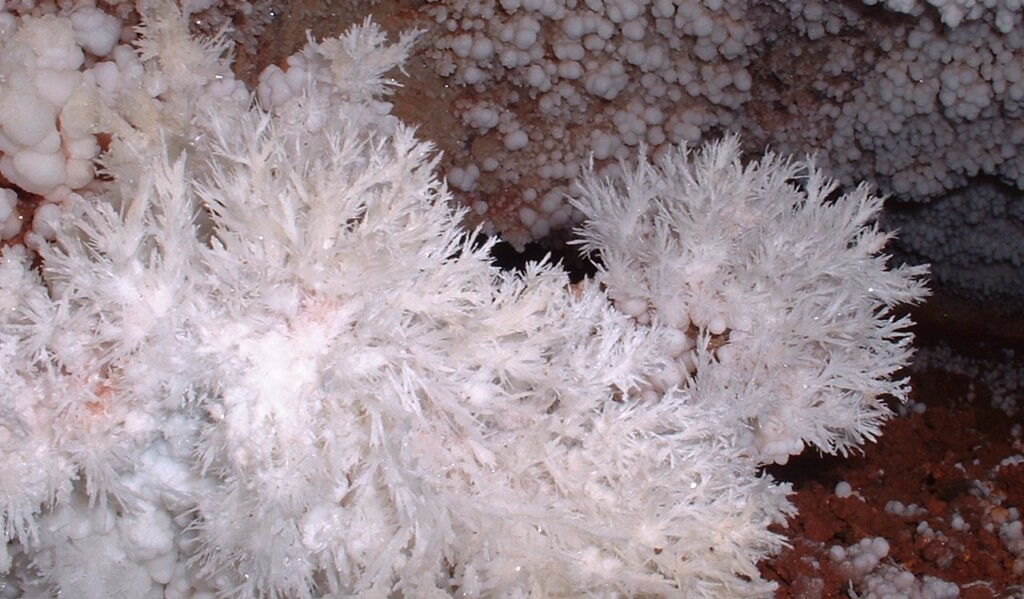
Finally for floor features, we have conulites! These structures are shaped like upside-down cones. They form in sediment-covered cave floors as water drips from above, digging a cone-shaped hole in the soil, and then coating the sides of that hole in minerals. If the sediment is later washed away, the conulites may remain, resembling ice cream cones or bird baths.
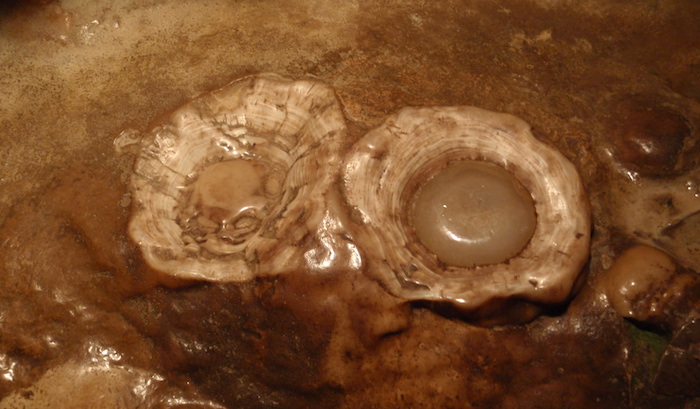
Image credit: ZeWrestler. Released under a CC BY-SA 3.0 license.
What about speleothems that form around pools? If you have a chamber or pool that’s only partially full of water but has a consistent water level, stone shelves may form along the walls at the water’s surface. If the chamber used to be dry and stalagmites formed before it was re-flooded, shelfstone can form attached to the stalagmites. The result is a room that may or may not have water in it when you enter, but has stone platforms throughout, some of them several meters wide. If water level fluctuated, you might even have shelfstone at multiple heights. Usually, shelfstone is only a few centimeters thick, so it’s unlikely to support the weight of a PC, but small monsters could absolutely use it to get around and fire down on the PCs from above.
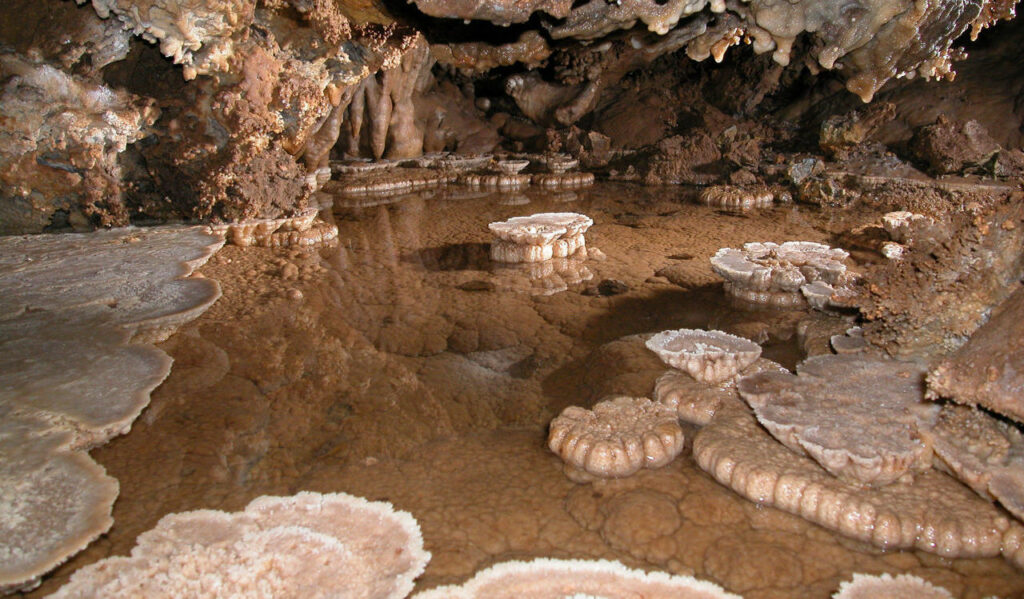
Image credit: Dave Bunnell. Released under a CC BY-SA 3.0 license.
In a similar vein, ‘cave rafts’ can form atop the surface of the water. These mineral deposits are paper thin (any thicker and they wouldn’t float), and can form along the water’s edge like shelfstone or free-floating in the middle of a pool. PCs who mistake cave rafts for platforms will get a wet surprise, since the structures can’t support any weight.
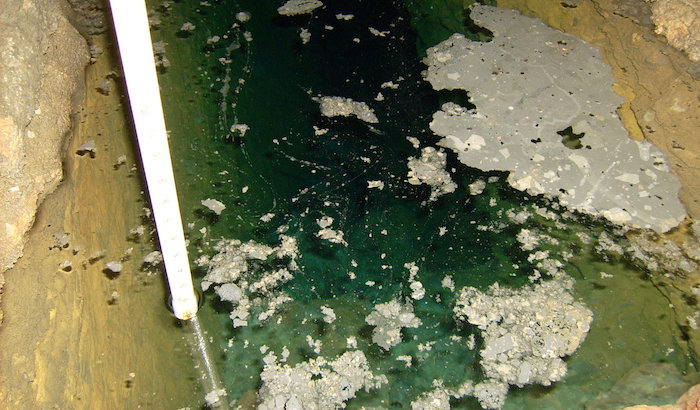
Finally, rimstone also forms along the edges of pools, but instead of growing out, it grows up. Especially at the spot where the pool spills out into a tiny stream, rimstone forms a dam that grows up and up, making the pool deeper and deeper. You can have several rimstone dams forming successive pools that spill one into another. You could easily see an adventurer getting her foot caught in one of these narrow rimstone pools, and they honestly just look super weird.
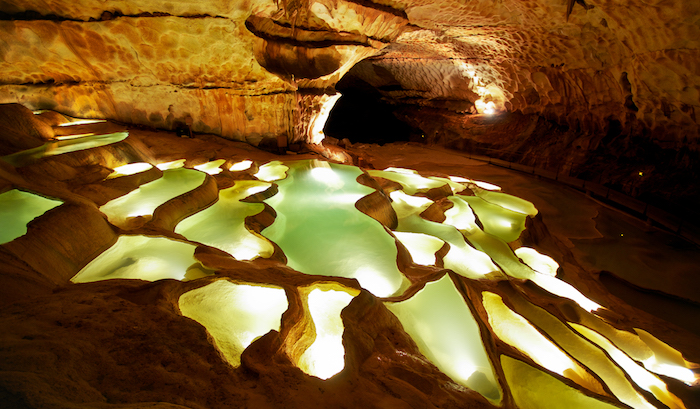
Image credit: Getfunky Paris. Released under a CC BY 2.0 license
–
Source: Cave Geology by Arthur N. Palmer (2007)






